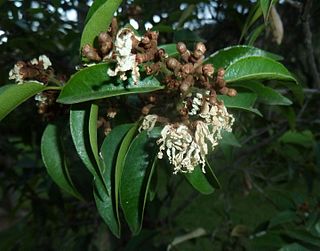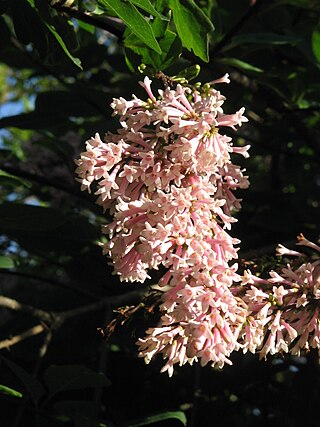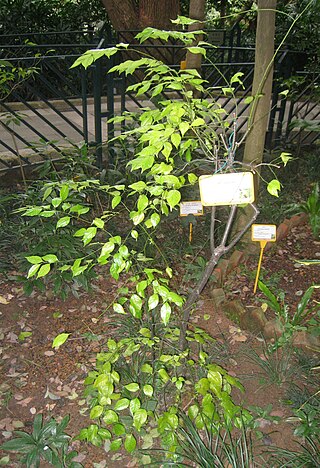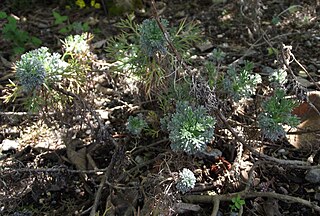Description
A climbing vine with long runners, entire plant pubescence. The stem can reach 4 to 5 m (13 to 16 ft) in length and is often branched. Alternating elliptical leaves, 6 to 10 cm (2.4 to 3.9 in) in length and 2 to 3.5 cm (0.79 to 1.38 in) in width, with an acute apex and ovate base. The leaves are entire and coriaceous. The adaxial surface is green, conduplicate, with pubescent in the midrib, while the abaxial surface is lighter in color, cucullate, and pilose. Four lateral veins and fine veins are present on each side. The petiole is 0.2 to 0.5 cm (0.079 to 0.197 in) in length. [4]
The flowers are small and arranged in cymes of 3, axillary, with a diameter of 0.6 to 0.8 cm (0.24 to 0.31 in) when open. The pedicel is hairy and slender, approximately 2 to 3 cm (0.79 to 1.18 in) in length, with 2 bracts in the center. The calyx is imbricate with 5 ovate lobes, acute at the apex and hairy at the front. There are 5 opposite ovate, hairy, petals with an acute apex and an acuminate back. The number of petals is the same as the number of stamens, with sider filaments. The anthers are sparsely hairy at the front. The disk is annular with indistinct lobules. The ovary is bilocular, glabrous, and smooth. The fruit is a globose drupe, 0.8 to 0.9 cm (0.31 to 0.35 in) in diameter, blue-black when mature. The flowering period is from March to April while the fruiting period is from July to September. [4]

Pachypodium baronii, the Madagascar palm or bontaka, is a flowering plant in the family Apocynaceae. It has the habit of a robust shrub with a spherical or bottle-shaped trunk. It has several cylindrical branches at the top.
Pachypodium bicolor is a species of plant in the family Apocynaceae.

Pachypodium brevicaule is a species of plant that belongs to the family Apocynaceae.

Cladrastis kentukea, the Kentucky yellowwood or American yellowwood, is a species of Cladrastis native to the Southeastern United States, with a restricted range from western North Carolina west to eastern Oklahoma, and from southern Missouri and Indiana south to central Alabama. The tree is sometimes also called Virgilia.

Prunus maackii, commonly called the Manchurian cherry or Amur chokecherry, is a species of cherry native to Korea and both banks of the Amur River, in Manchuria in northeastern China, and Amur Oblast and Primorye in southeastern Russia. It used to be considered a species of Prunus subg. Padus, but both morphological and molecular studies indicate it belongs to Prunus subg. Cerasus.

Trichocladus grandiflorus is a species in the genus Trichocladus, in the family Hamamelidaceae. It is also called splendid witch-hazel.

Syringa tomentella is a species in the genus Syringa, in the family Oleaceae.
Hypericum acmosepalum is a dwarf shrub in Hypericumsect. Ascyreia that is native to China and known as jian e jin si tao locally.

Ilex asprella, also known as rough-leaved holly and plum-leaved holly, is a deciduous shrub native in South East Asia. Ilex asprella is one of the few deciduous species in the family Aquifoliaceae.

Prunus himalayana, called jyokun shin in Tibetan and 喜马拉雅臭樱 in Chinese, is a species of Prunus native to Nepal, Bhutan, Sikkim and Tibet. It prefers to grow 2,800 to 4,200 m above sea level in the Himalayas. As Maddenia himalaica it was the type species for the now unrecognized genus Maddenia.
Passiflora quetzal is a species of flowering plant native to Mexico and Guatemala described in 2004. It is named after the quetzal, which inhabits the area.

Pachysandra axillaris is a species of plant in the family Buxaceae. In its native China, it is known as 板凳果.

Iberis amara, called wild candytuft, rocket candytuft and bitter candytuft, is a species of flowering plant in the family Brassicaceae, native to Belgium, France, Germany, Great Britain, Italy, Spain, and Switzerland. It has been introduced to numerous locations including Algeria, Sweden, Eastern Europe, the Caucasus, Iraq, Kazakhstan, the Indian Subcontinent, Korea, Far Eastern Russia, New Zealand, Argentina, Ecuador, Hispaniola, the United States, and Canada. It prefers to grow in warm and sunny conditions, in high-calcium soil.
Zanthoxylum laetum is a species of woody plant from the Rutaceae family.
Zanthoxylum micranthum is a woody plant in the family Rutaceae. It is native to Hubei, Hunan, Guizhou, Sichuan, and Yunnan provinces in China.
Zanthoxylum undulatifolium is a woody plant from the Rutaceae family. It is native to western Hubei, eastern Sichuan, Taibai Mountain in southern Shaanxi to the Three Gorges of the Yangtze River in China.
Cardamine griffithii is a species of herb characterized by angled or grooved stems that are sparsely branched above and can reach heights of up to 60 cm. The plant is glabrous, meaning it lacks hair or trichomes.
Lonicera kawakamii, also known as Yushan honeysuckle or Kawakami’s honeysuckle, is a species of the Lonicera genus in the Caprifoliaceae family that is endemic to Taiwan. The plant is distributed at altitudes between 3000 and 3900 meters in Taiwan. It as “Vulnerable” in the “Red List of Vascular Plants of Taiwan, 2017”.
Rubus swinhoei is also known as Swinhoe's raspberry, wood berry, Keelung rubus, Jingbai rubus and Libai rubus. It belongs to the genus Rubus of the family Rosaceae and is named after Robert Swinhoe for his contributions to Taiwan’s fauna and flora.

Artemisia kawakamii, commonly known as Kawakami's mugwort, is a plant in the Artemisia genus under the Asteraceae family that is endemic to Taiwan. The plant is distributed on the Taiwan island, growing at elevations from 2,700 to 3,300 m. It is commonly found in gravelly, open, and arid slopes. The species has yet to be cultivated.











